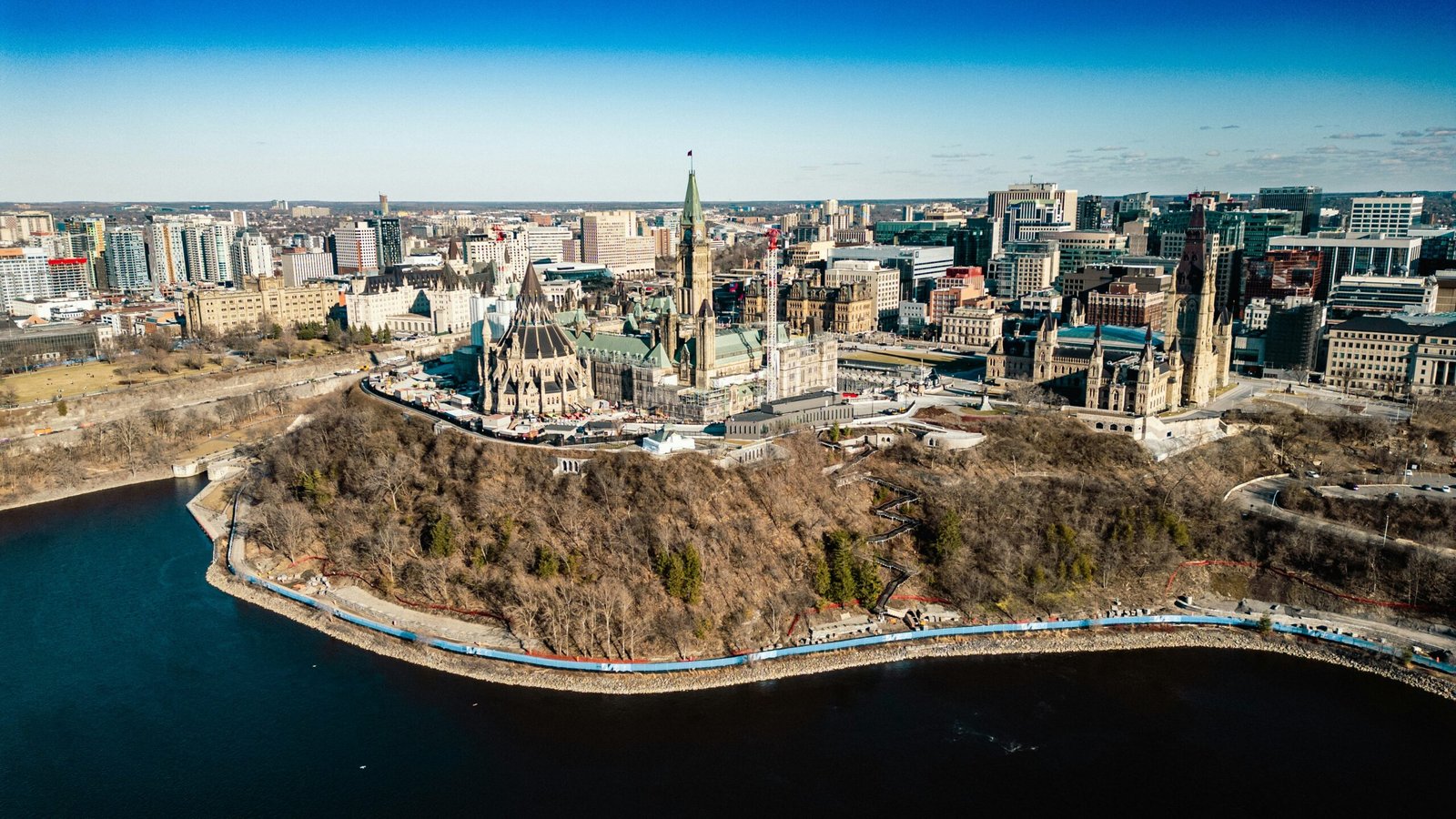The Library of Parliament, standing proudly in Ottawa, Canada, is a testament to the nation’s rich history and architectural prowess. Conceived as an integral part of the original Parliament Buildings, the library was designed with inspiration drawn from the British Museum’s grand reading room. This influence is evident in the library’s iconic structure, which has become a symbol of Canadian heritage and intellectual pursuit.
The library’s design was spearheaded by noted architects Thomas Fuller and Chilion Jones, who were chosen through a competition held in 1859. Their architectural plan, characterized by its Victorian High Gothic style, serves as a timeless landmark. One of the most striking features of the building is its elaborate exterior, highlighted by sixteen flying buttresses that provide both structural support and aesthetic grandeur. These buttresses, along with the library’s polygonal shape, create a visually captivating silhouette against the Ottawa skyline.
Delving inside the Library of Parliament, visitors are awestruck by the vaulted ceiling of the main reading room. This feature not only accentuates the room’s spaciousness but also allows natural light to filter in, creating an atmosphere of serene scholarly focus. The intricate white pine paneling that adorns the interior walls is another noteworthy aspect. These panels are meticulously carved with images of flowers, masks, and mythical creatures, showcasing an incredible level of craftsmanship and attention to detail.
A testament to its significance, the Library of Parliament has been immortalized on Canada’s ten-dollar bill. This recognition underscores its status not merely as a repository of knowledge but as an enduring emblem of Canadian culture and history. The library’s ability to withstand the test of time is a reflection of its foundational importance to the nation and its dedication to preserving Canada’s intellectual and cultural legacies.
Extensive Collection
The Library of Parliament, a cornerstone of Canada’s legislative and informational infrastructure, boasts an impressive collection exceeding 600,000 items. This vast repository is meticulously curated to meet the diverse informational needs of Canadian parliamentarians, governmental staff, and researchers, making it an invaluable national resource. The collection encompasses an extensive range of materials including historical manuscripts, legal texts, governmental reports, and a vast array of rare books.
One of the library’s distinguishing features is its robust collection of historical manuscripts, which provide invaluable insights into Canada’s legislative history and development. These documents not only include foundational legal texts and early parliamentary records but also personal papers of notable figures in Canadian politics. Researchers can delve into these manuscripts to explore the evolution of Canadian law and policy, gaining a thorough understanding of the country’s legislative heritage.
The legal texts available in the library are equally comprehensive, covering a wide spectrum of areas from constitutional law to criminal justice. These texts are essential for parliamentarians who rely on them to draft, evaluate, and amend legislative proposals. Meanwhile, the collection of governmental reports provides detailed analyses and insights into various aspects of public administration, economics, and social policy, reflecting the government’s ongoing efforts to address national challenges.
A particularly fascinating aspect of the Library of Parliament’s holdings is the rare books collection, which includes early editions and invaluable works that reflect the cultural and intellectual history of Canada. These rare volumes are carefully preserved and provide unique perspectives on the country’s past.
To maintain and organize these extensive resources, the library employs a dedicated staff of over 300 members who specialize in various aspects of library science. This team ensures that the collection is meticulously cataloged, facilitating easy access for users. They also play a crucial role in acquiring notable new materials and preserving the integrity of Canada’s legislative and historical records.
Accessibility and Public Engagement
The Library of Parliament in Ottawa, while primarily dedicated to the service of Canadian parliamentary business, extends its influence far beyond the legislative precincts through a variety of public engagement initiatives. To balance its restricted access with broader public interest, the library offers guided tours and educational programs. Public tours provide a unique glimpse into this national treasure, featuring its awe-inspiring architecture and showcasing the breadth of its collections. These tours are carefully curated to offer informative experiences without disrupting the library’s primary function.
Visitors interested in public tours can easily schedule their visits online through the library’s official website. These tours are generally conducted by knowledgeable guides who are adept at elucidating the library’s historical significance and contemporary relevance. In addition to regular tours, the Library of Parliament organizes special exhibitions that shine a light on various aspects of Canadian history and culture. These exhibitions are usually thematic and often coincide with significant national anniversaries or public events, enhancing the library’s mission of education and public service.
Educational initiatives constitute another vital pillar of the library’s public engagement strategy. Catering to a diverse audience, from students and researchers to history enthusiasts, these programs range from workshops and seminars to curated lectures delivered by experts. The library’s commitment to education extends into the digital realm as well, offering online resources that can be accessed by anyone. Digital archives, research databases, and virtual tours ensure that the Library of Parliament’s valuable resources are available to a global audience, thereby transcending geographical constraints.
Public outreach is instrumental in promoting the Library of Parliament’s mission and enhancing its visibility. By engaging directly with the community, the library not only disseminates knowledge but also fosters a deeper appreciation for Canadian heritage. These efforts in public engagement are essential in ensuring that the Library of Parliament remains a revered institution, cherished not only by Canadians but also by international visitors who seek to understand the Canadian democratic system and its cultural heritage.
Future Prospects
Maintaining a national treasure as venerable as the Library of Parliament presents a spectrum of challenges and opportunities. Among the foremost considerations are preservation efforts that include extensive restoration projects and modernization plans. These initiatives are critical not only to safeguard the historical architecture, which is an exemplary showcase of 19th-century Gothic Revival style but also to ensure that the library continues to meet contemporary needs.
The restoration projects often involve meticulous planning and execution. Specialists in heritage conservation work to restore and preserve delicate details, from ornate woodwork to period-appropriate furnishings. Concurrently, modernization plans focus on integrating state-of-the-art technology without compromising the aesthetic and historical integrity of the library. For example, the implementation of advanced climate control systems is pivotal for the preservation of fragile collections, while modern IT infrastructure supports the digital aspirations of this historical institution.
One significant challenge lies in navigating the complexities of digital transformation. The Library of Parliament, like many historical libraries, must adapt to the evolving landscape where digital resources are increasingly prioritized over traditional print collections. This necessitates digitizing vast amounts of information while ensuring it remains accessible and secure. The balance is delicate, as the library must cater to both its traditional users, who value tangible books and documents, and a newer demographic that relies heavily on digital access.
Funding constraints further complicate these efforts. Public and private financial support is essential to underpin both preservation and modernization initiatives. However, securing adequate funding is an ongoing challenge, requiring strategic planning and continuous advocacy to demonstrate the library’s significance and evolving role.
Looking ahead, the future prospects for the Library of Parliament are promising, albeit complex. Fostering partnerships with technological experts, educational institutions, and cultural organizations can help the library navigate its transformation. Additionally, evolving user needs, including increased demand for digital access and multifunctional spaces, must be met through adaptive strategies. By addressing these challenges and leveraging emerging opportunities, the Library of Parliament can continue to serve as an indispensable information resource in Canada’s digital age.

